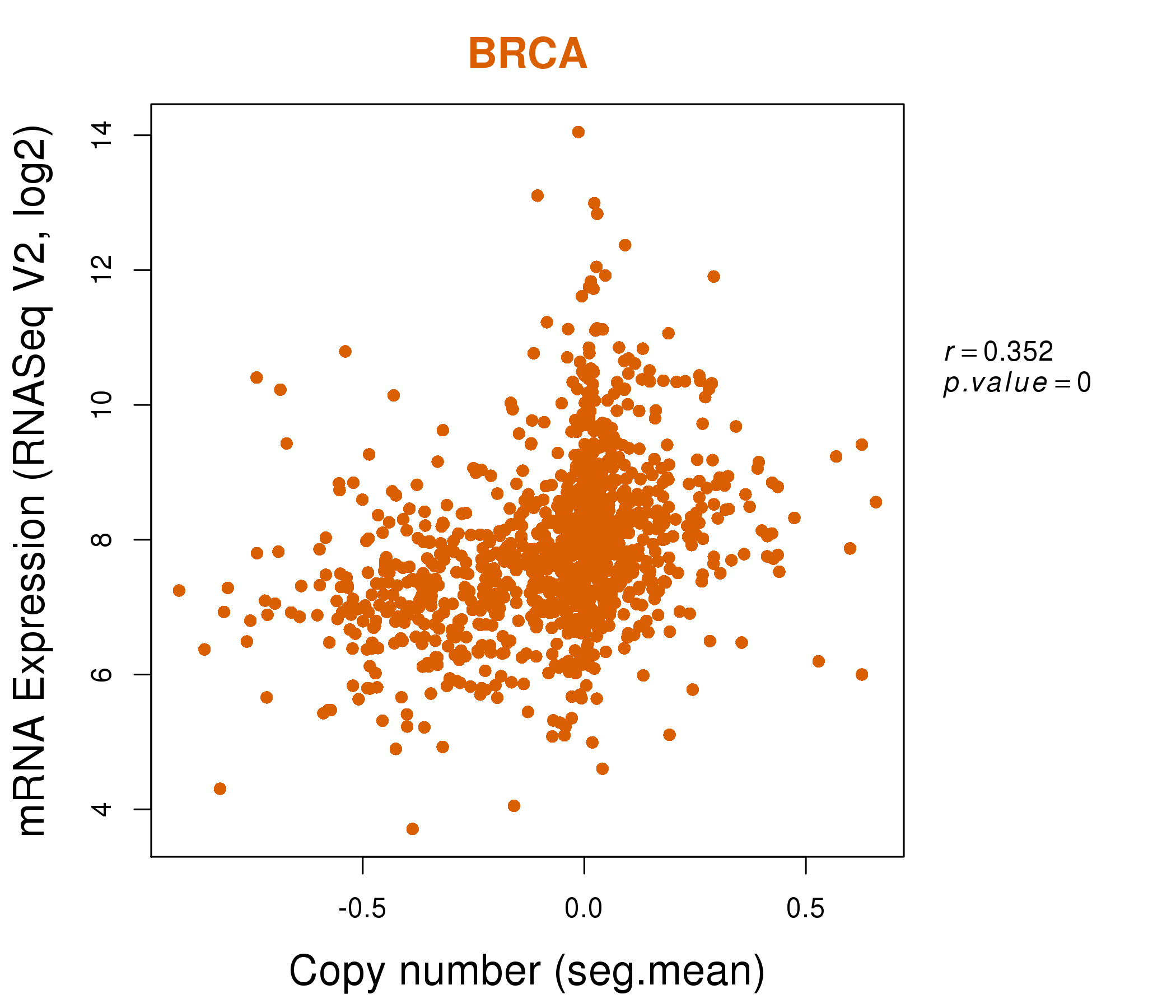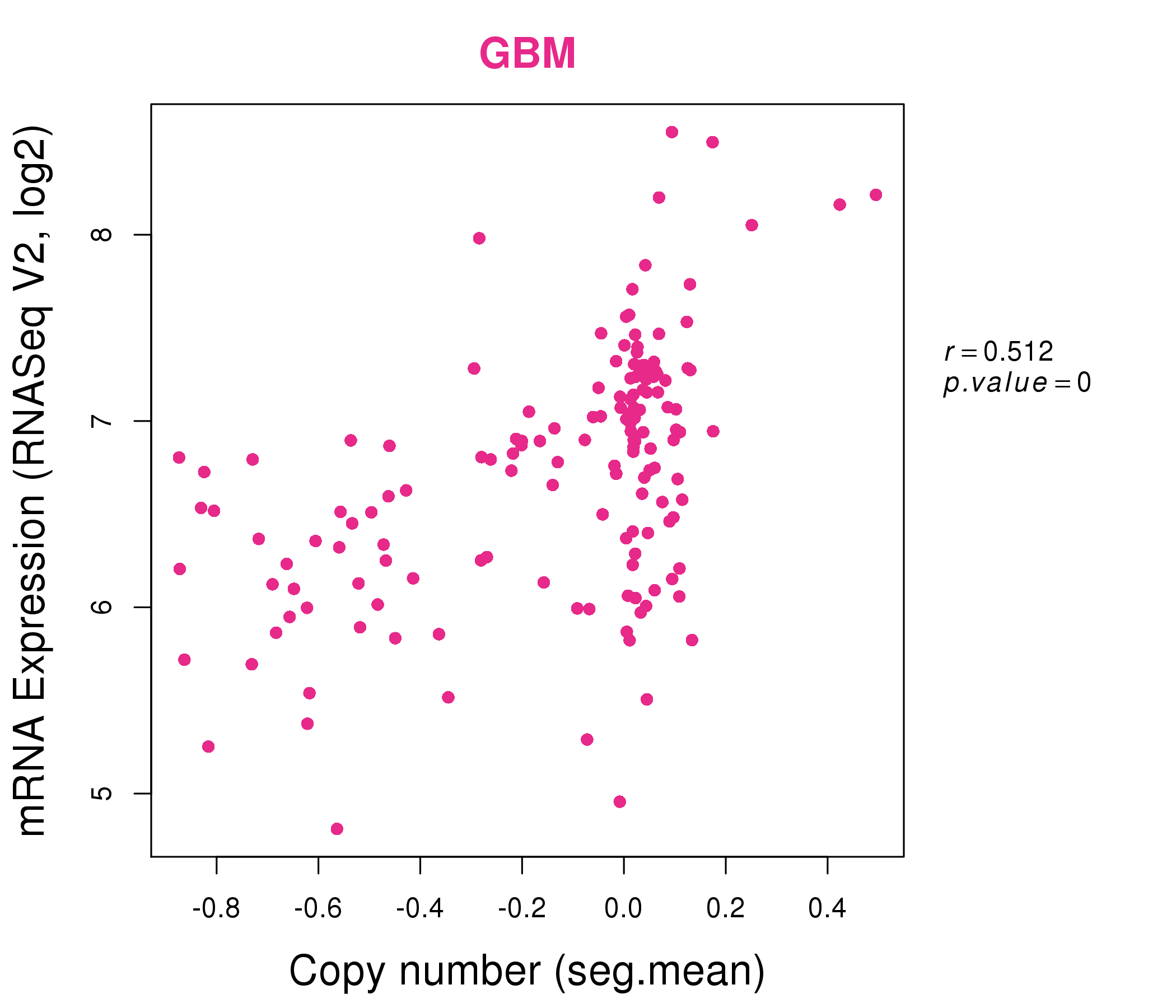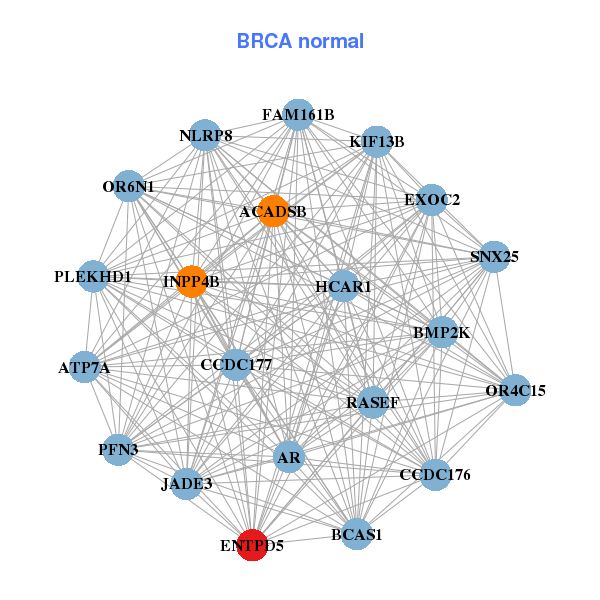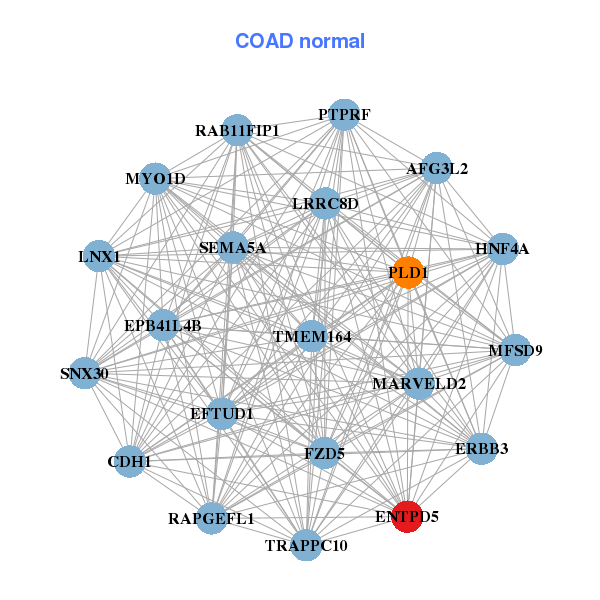|
||||||||||||||||||||||||||||||||||||||||||||||||||||||||||||||||||||||||||||||||||||||||||||||||||||||||||||||||||||||||||||||||||||||||||||||||||||||||||||||||||||||||||||||||||||||||||||||||||||||||||||||||||||||||||||||||||||||||||||||||||||||||||||||||||||||||||||||||||||||||||||||||||||||||||||||||||||||||||
| |
| Phenotypic Information (metabolism pathway, cancer, disease, phenome) |
| |
| |
| Gene-Gene Network Information: Co-Expression Network, Interacting Genes & KEGG |
| |
|
| Gene Summary for ENTPD5 |
| Basic gene info. | Gene symbol | ENTPD5 |
| Gene name | ectonucleoside triphosphate diphosphohydrolase 5 | |
| Synonyms | CD39L4|NTPDase-5|PCPH | |
| Cytomap | UCSC genome browser: 14q24 | |
| Genomic location | chr14 :74433180-74486026 | |
| Type of gene | protein-coding | |
| RefGenes | NM_001249.2, | |
| Ensembl id | ENSG00000187097 | |
| Description | CD39 antigen-like 4CD39-like 4ER-UDPaseGDPase ENTPD5NTPDase 5Pcph proto-oncogene proteinUDPase ENTPD5guanosine-diphosphatase ENTPD5nucleoside diphosphataseproto-oncogene CPHuridine-diphosphatase ENTPD5 | |
| Modification date | 20141207 | |
| dbXrefs | MIM : 603162 | |
| HGNC : HGNC | ||
| HPRD : 16015 | ||
| Protein | UniProt: O75356 go to UniProt's Cross Reference DB Table | |
| Expression | CleanEX: HS_ENTPD5 | |
| BioGPS: 957 | ||
| Gene Expression Atlas: ENSG00000187097 | ||
| The Human Protein Atlas: ENSG00000187097 | ||
| Pathway | NCI Pathway Interaction Database: ENTPD5 | |
| KEGG: ENTPD5 | ||
| REACTOME: ENTPD5 | ||
| ConsensusPathDB | ||
| Pathway Commons: ENTPD5 | ||
| Metabolism | MetaCyc: ENTPD5 | |
| HUMANCyc: ENTPD5 | ||
| Regulation | Ensembl's Regulation: ENSG00000187097 | |
| miRBase: chr14 :74,433,180-74,486,026 | ||
| TargetScan: NM_001249 | ||
| cisRED: ENSG00000187097 | ||
| Context | iHOP: ENTPD5 | |
| cancer metabolism search in PubMed: ENTPD5 | ||
| UCL Cancer Institute: ENTPD5 | ||
| Assigned class in ccmGDB | A - This gene has a literature evidence and it belongs to cancer gene. | |
| References showing role of ENTPD5 in cancer cell metabolism | 1. Curry NL, Mino-Kenudson M, Oliver TG, Yilmaz OH, Yilmaz VO, et al. (2013) Pten-null tumors cohabiting the same lung display differential AKT activation and sensitivity to dietary restriction. Cancer Discov 3: 908-921. doi: 10.1158/2159-8290.CD-12-0507. pmid: 3743121. go to article 2. Zadran S, Amighi A, Otiniano E, Wong K, Zadran H (2012) ENTPD5-mediated modulation of ATP results in altered metabolism and decreased survival in gliomablastoma multiforme. Tumour Biol 33: 2411-2421. doi: 10.1007/s13277-012-0505-1. go to article 3. Shen Z, Huang S, Fang M, Wang X (2011) ENTPD5, an endoplasmic reticulum UDPase, alleviates ER stress induced by protein overloading in AKT-activated cancer cells. Cold Spring Harb Symp Quant Biol 76: 217-223. doi: 10.1101/sqb.2011.76.010876. go to article 4. Israelsen WJ, Vander Heiden MG (2010) ATP consumption promotes cancer metabolism. Cell 143: 669-671. doi: 10.1016/j.cell.2010.11.010. go to article 5. MacCarthy CM, Notario V (2013) The ENTPD5/mt-PCPH oncoprotein is a catalytically inactive member of the ectonucleoside triphosphate diphosphohydrolase family. Int J Oncol 43: 1244-1252. doi: 10.3892/ijo.2013.2052. pmid: 3829800. go to article | |
| Top |
| Phenotypic Information for ENTPD5(metabolism pathway, cancer, disease, phenome) |
| Cancer | CGAP: ENTPD5 |
| Familial Cancer Database: ENTPD5 | |
| * This gene is included in those cancer gene databases. |
|
|
|
|
|
|
| ||||||||||||||||||||||||||||||||||||||||||||||||||||||||||||||||||||||||||||||||||||||||||||||||||||||||||||||||||||||||||||||||||||||||||||||||||||||||||||||||||||||||||||||||||||||||||||||||||||||||||||||||||||||||||||||||||||||||||||||||||||||||||||||||||||||||||||||||||||||||||||||||||||||||||||||||||||
Oncogene 1 | Significant driver gene in | |||||||||||||||||||||||||||||||||||||||||||||||||||||||||||||||||||||||||||||||||||||||||||||||||||||||||||||||||||||||||||||||||||||||||||||||||||||||||||||||||||||||||||||||||||||||||||||||||||||||||||||||||||||||||||||||||||||||||||||||||||||||||||||||||||||||||||||||||||||||||||||||||||||||||||||||||||||||||
| cf) number; DB name 1 Oncogene; http://nar.oxfordjournals.org/content/35/suppl_1/D721.long, 2 Tumor Suppressor gene; https://bioinfo.uth.edu/TSGene/, 3 Cancer Gene Census; http://www.nature.com/nrc/journal/v4/n3/abs/nrc1299.html, 4 CancerGenes; http://nar.oxfordjournals.org/content/35/suppl_1/D721.long, 5 Network of Cancer Gene; http://ncg.kcl.ac.uk/index.php, 1Therapeutic Vulnerabilities in Cancer; http://cbio.mskcc.org/cancergenomics/statius/ |
| KEGG_PURINE_METABOLISM KEGG_PYRIMIDINE_METABOLISM | |
| OMIM | 603162; gene. |
| Orphanet | |
| Disease | KEGG Disease: ENTPD5 |
| MedGen: ENTPD5 (Human Medical Genetics with Condition) | |
| ClinVar: ENTPD5 | |
| Phenotype | MGI: ENTPD5 (International Mouse Phenotyping Consortium) |
| PhenomicDB: ENTPD5 | |
| Mutations for ENTPD5 |
| * Under tables are showing count per each tissue to give us broad intuition about tissue specific mutation patterns.You can go to the detailed page for each mutation database's web site. |
| There's no structural variation information in COSMIC data for this gene. |
| * From mRNA Sanger sequences, Chitars2.0 arranged chimeric transcripts. This table shows ENTPD5 related fusion information. |
| ID | Head Gene | Tail Gene | Accession | Gene_a | qStart_a | qEnd_a | Chromosome_a | tStart_a | tEnd_a | Gene_a | qStart_a | qEnd_a | Chromosome_a | tStart_a | tEnd_a |
| BG402857 | ENTPD5 | 30 | 81 | 14 | 74431132 | 74431183 | ENTPD5 | 79 | 724 | 14 | 74430496 | 74431152 | |
| AW578884 | ENTPD5 | 31 | 339 | 14 | 74433567 | 74438597 | TCTN3 | 332 | 573 | 10 | 97423888 | 97440300 | |
| Top |
| Mutation type/ Tissue ID | brca | cns | cerv | endome | haematopo | kidn | Lintest | liver | lung | ns | ovary | pancre | prost | skin | stoma | thyro | urina | |||
| Total # sample | 1 | 1 | ||||||||||||||||||
| GAIN (# sample) | 1 | 1 | ||||||||||||||||||
| LOSS (# sample) |
| cf) Tissue ID; Tissue type (1; Breast, 2; Central_nervous_system, 3; Cervix, 4; Endometrium, 5; Haematopoietic_and_lymphoid_tissue, 6; Kidney, 7; Large_intestine, 8; Liver, 9; Lung, 10; NS, 11; Ovary, 12; Pancreas, 13; Prostate, 14; Skin, 15; Stomach, 16; Thyroid, 17; Urinary_tract) |
| Top |
|
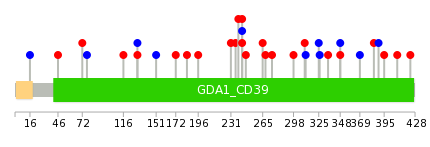 |
| Top |
| Stat. for Non-Synonymous SNVs (# total SNVs=21) | (# total SNVs=8) |
 | 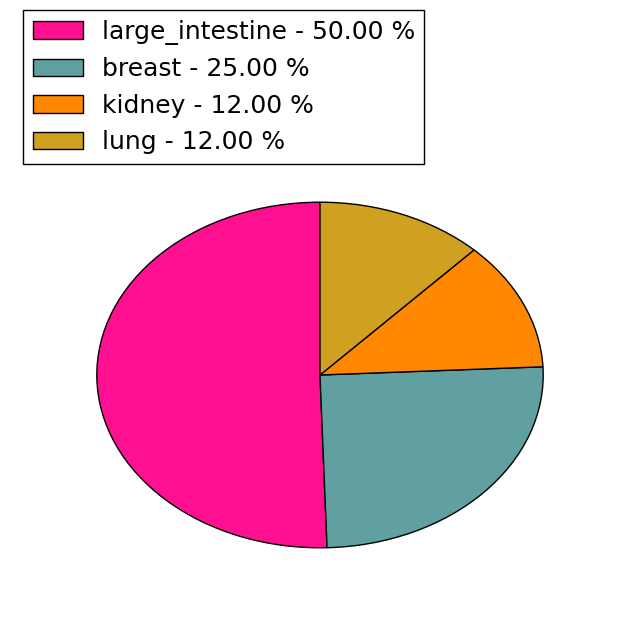 |
(# total SNVs=0) | (# total SNVs=1) |
 |
| Top |
| * When you move the cursor on each content, you can see more deailed mutation information on the Tooltip. Those are primary_site,primary_histology,mutation(aa),pubmedID. |
| GRCh37 position | Mutation(aa) | Unique sampleID count |
| chr14:74440688-74440688 | p.? | 2 |
| chr14:74441684-74441684 | p.L243L | 2 |
| chr14:74436730-74436730 | p.D395H | 1 |
| chr14:74449813-74449813 | p.R117* | 1 |
| chr14:74439698-74439698 | p.E306* | 1 |
| chr14:74442670-74442670 | p.F231L | 1 |
| chr14:74436746-74436746 | p.D389D | 1 |
| chr14:74449816-74449816 | p.P116S | 1 |
| chr14:74439721-74439721 | p.V298G | 1 |
| chr14:74443083-74443083 | p.G196W | 1 |
| Top |
|
 |
| Point Mutation/ Tissue ID | 1 | 2 | 3 | 4 | 5 | 6 | 7 | 8 | 9 | 10 | 11 | 12 | 13 | 14 | 15 | 16 | 17 | 18 | 19 | 20 |
| # sample | 2 | 3 | 2 | 1 | 1 | 1 | 5 | 2 | ||||||||||||
| # mutation | 2 | 3 | 2 | 1 | 1 | 1 | 5 | 2 | ||||||||||||
| nonsynonymous SNV | 1 | 1 | 2 | 1 | 1 | 2 | ||||||||||||||
| synonymous SNV | 1 | 2 | 1 | 1 | 4 |
| cf) Tissue ID; Tissue type (1; BLCA[Bladder Urothelial Carcinoma], 2; BRCA[Breast invasive carcinoma], 3; CESC[Cervical squamous cell carcinoma and endocervical adenocarcinoma], 4; COAD[Colon adenocarcinoma], 5; GBM[Glioblastoma multiforme], 6; Glioma Low Grade, 7; HNSC[Head and Neck squamous cell carcinoma], 8; KICH[Kidney Chromophobe], 9; KIRC[Kidney renal clear cell carcinoma], 10; KIRP[Kidney renal papillary cell carcinoma], 11; LAML[Acute Myeloid Leukemia], 12; LUAD[Lung adenocarcinoma], 13; LUSC[Lung squamous cell carcinoma], 14; OV[Ovarian serous cystadenocarcinoma ], 15; PAAD[Pancreatic adenocarcinoma], 16; PRAD[Prostate adenocarcinoma], 17; SKCM[Skin Cutaneous Melanoma], 18:STAD[Stomach adenocarcinoma], 19:THCA[Thyroid carcinoma], 20:UCEC[Uterine Corpus Endometrial Carcinoma]) |
| Top |
| * We represented just top 10 SNVs. When you move the cursor on each content, you can see more deailed mutation information on the Tooltip. Those are primary_site, primary_histology, mutation(aa), pubmedID. |
| Genomic Position | Mutation(aa) | Unique sampleID count |
| chr14:74438596 | p.T263S | 1 |
| chr14:74444005 | p.K236R | 1 |
| chr14:74439610 | p.F231L | 1 |
| chr14:74444066 | p.G201G | 1 |
| chr14:74439636 | p.G196W | 1 |
| chr14:74449769 | p.E172K | 1 |
| chr14:74439639 | p.I151I | 1 |
| chr14:74449771 | p.A131A | 1 |
| chr14:74439681 | p.D389D | 1 |
| chr14:74454758 | p.A131P | 1 |
| * Copy number data were extracted from TCGA using R package TCGA-Assembler. The URLs of all public data files on TCGA DCC data server were gathered on Jan-05-2015. Function ProcessCNAData in TCGA-Assembler package was used to obtain gene-level copy number value which is calculated as the average copy number of the genomic region of a gene. |
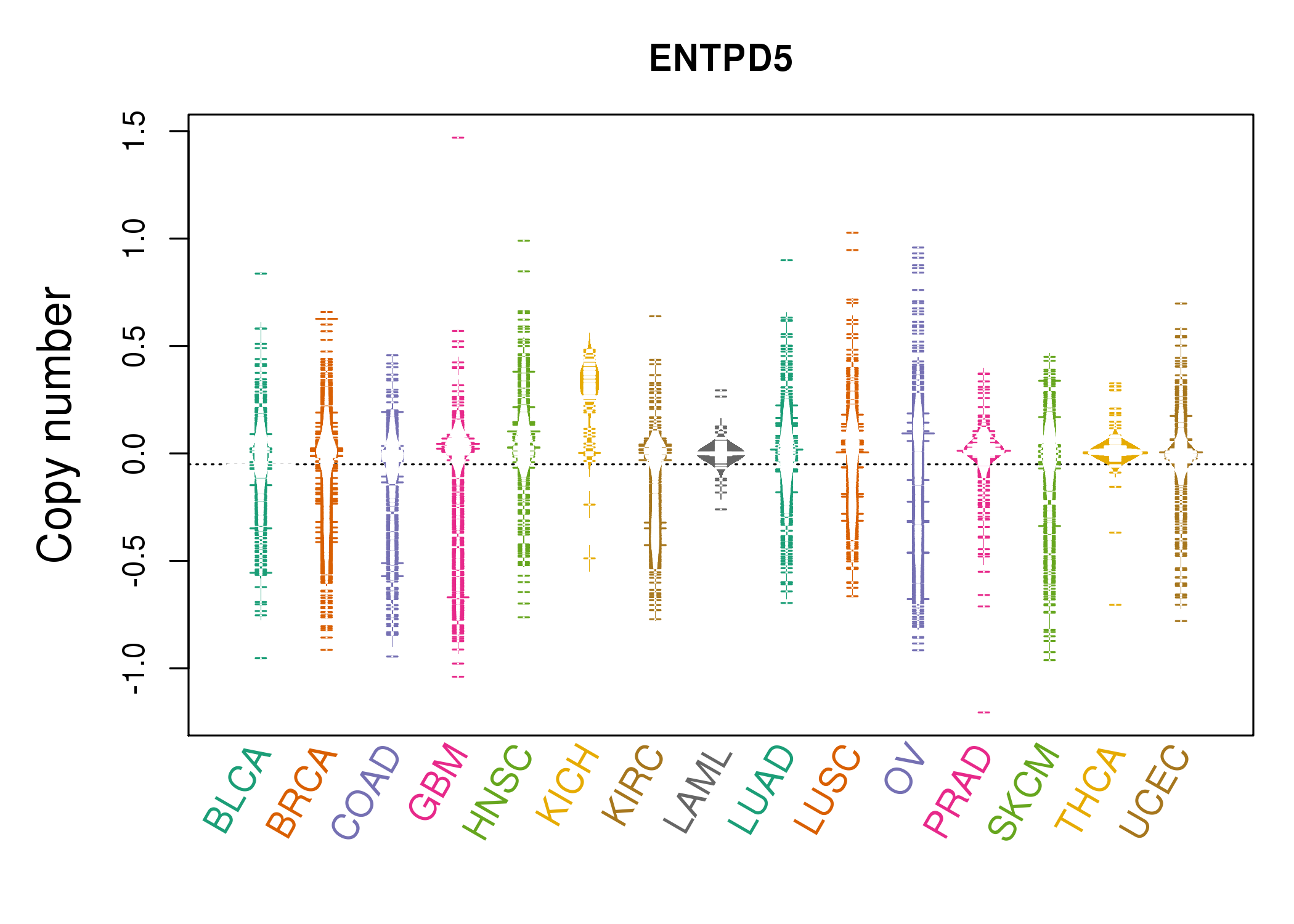 |
| cf) Tissue ID[Tissue type]: BLCA[Bladder Urothelial Carcinoma], BRCA[Breast invasive carcinoma], CESC[Cervical squamous cell carcinoma and endocervical adenocarcinoma], COAD[Colon adenocarcinoma], GBM[Glioblastoma multiforme], Glioma Low Grade, HNSC[Head and Neck squamous cell carcinoma], KICH[Kidney Chromophobe], KIRC[Kidney renal clear cell carcinoma], KIRP[Kidney renal papillary cell carcinoma], LAML[Acute Myeloid Leukemia], LUAD[Lung adenocarcinoma], LUSC[Lung squamous cell carcinoma], OV[Ovarian serous cystadenocarcinoma ], PAAD[Pancreatic adenocarcinoma], PRAD[Prostate adenocarcinoma], SKCM[Skin Cutaneous Melanoma], STAD[Stomach adenocarcinoma], THCA[Thyroid carcinoma], UCEC[Uterine Corpus Endometrial Carcinoma] |
| Top |
| Gene Expression for ENTPD5 |
| * CCLE gene expression data were extracted from CCLE_Expression_Entrez_2012-10-18.res: Gene-centric RMA-normalized mRNA expression data. |
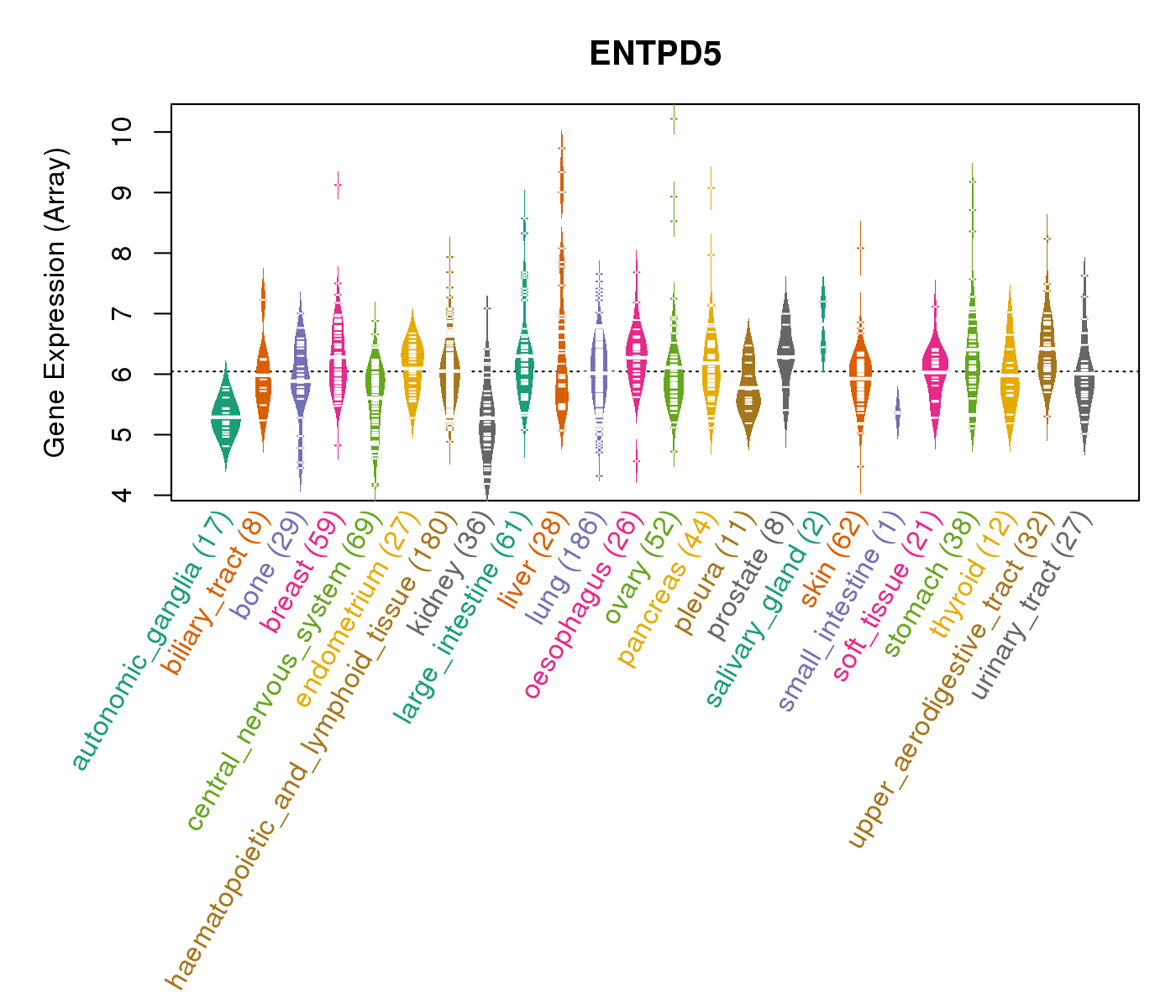 |
| * Normalized gene expression data of RNASeqV2 was extracted from TCGA using R package TCGA-Assembler. The URLs of all public data files on TCGA DCC data server were gathered at Jan-05-2015. Only eight cancer types have enough normal control samples for differential expression analysis. (t test, adjusted p<0.05 (using Benjamini-Hochberg FDR)) |
 |
| Top |
| * This plots show the correlation between CNV and gene expression. |
: Open all plots for all cancer types
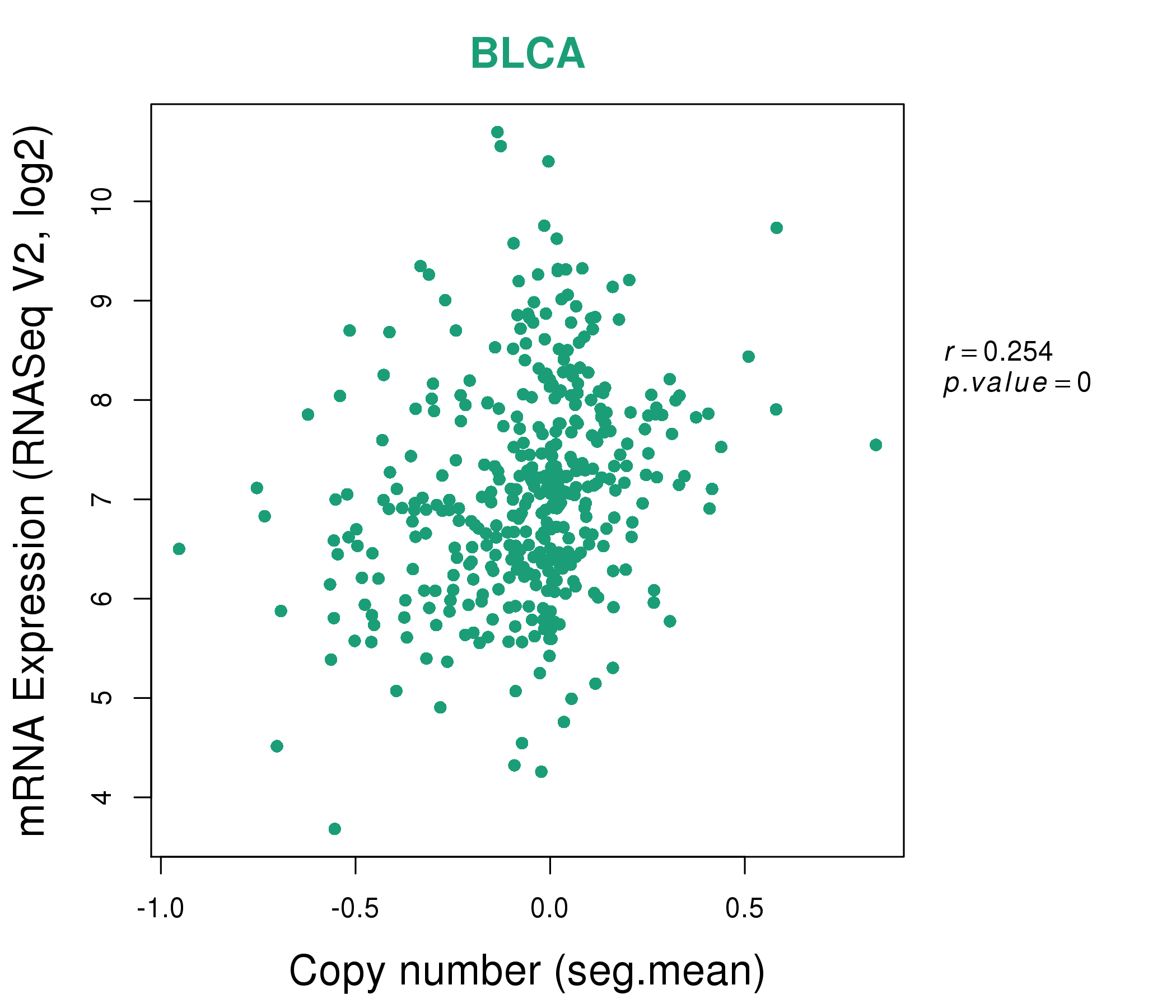 |
|
 |
|
| Top |
| Gene-Gene Network Information |
| * Co-Expression network figures were drawn using R package igraph. Only the top 20 genes with the highest correlations were shown. Red circle: input gene, orange circle: cell metabolism gene, sky circle: other gene |
: Open all plots for all cancer types
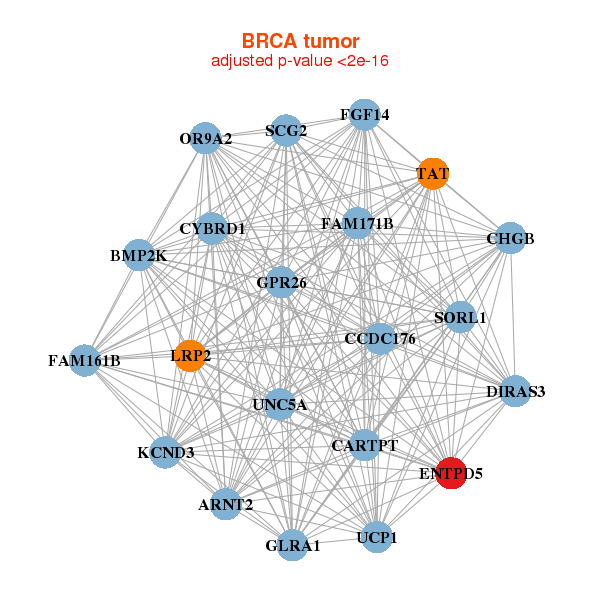 |
|
| ARNT2,BMP2K,CCDC176,CARTPT,CHGB,CYBRD1,DIRAS3, ENTPD5,FAM161B,FAM171B,FGF14,GLRA1,GPR26,KCND3, LRP2,OR9A2,SCG2,SORL1,TAT,UCP1,UNC5A | ACADSB,AR,ATP7A,BCAS1,BMP2K,CCDC177,CCDC176, ENTPD5,EXOC2,FAM161B,HCAR1,INPP4B,KIF13B,NLRP8, OR4C15,OR6N1,PFN3,JADE3,RASEF,SNX25,PLEKHD1 |
 |
|
| ANK3,SOWAHB,CLMN,ENTPD5,EPB41L4B,GPA33,GPD1L, KIAA1161,CIPC,LRRC19,NBEAL1,PDCD4,PLCE1,PLXNA2, SGK2,SLC16A9,SLC35D1,SOS2,SULT1B1,TMEM72,ZNF774 | AFG3L2,CDH1,EFTUD1,ENTPD5,EPB41L4B,ERBB3,FZD5, HNF4A,LNX1,LRRC8D,MARVELD2,MFSD9,MYO1D,PLD1, PTPRF,RAB11FIP1,RAPGEFL1,SEMA5A,SNX30,TMEM164,TRAPPC10 |
| * Co-Expression network figures were drawn using R package igraph. Only the top 20 genes with the highest correlations were shown. Red circle: input gene, orange circle: cell metabolism gene, sky circle: other gene |
: Open all plots for all cancer types
| Top |
: Open all interacting genes' information including KEGG pathway for all interacting genes from DAVID
| Top |
| Pharmacological Information for ENTPD5 |
| There's no related Drug. |
| Top |
| Cross referenced IDs for ENTPD5 |
| * We obtained these cross-references from Uniprot database. It covers 150 different DBs, 18 categories. http://www.uniprot.org/help/cross_references_section |
: Open all cross reference information
|
Copyright © 2016-Present - The Univsersity of Texas Health Science Center at Houston @ |






